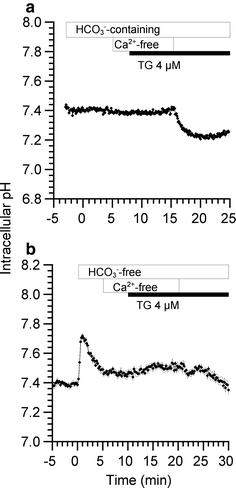HCO(3) (-)-dependent transient acidification induced by ionomycin in rat submandibular acinar cells
- PMID: 20495897
- PMCID: PMC10717291
- DOI: 10.1007/s12576-010-0095-x
HCO(3) (-)-dependent transient acidification induced by ionomycin in rat submandibular acinar cells
Abstract
Ionomycin (IM, 5 microM), which exchanges 1 Ca2+ for 1 H+, changed intracellular pH (pHi) with Ca2+ entry into rat submandibular acinar cells. IM-induced changes in pHi consisted of two components: the first is an HCO3--dependent transient pHi decrease, and the second is an HCO3--independent gradual pHi increase. IM (1 microM), which activates store-operated Ca2+ channels, induced an HCO3--dependent and transient pHi decrease without any HCO3--independent pHi increase. Thus, a gradual pHi increase was induced by the Ca2+/H+ exchange. The HCO3--dependent and transient pHi decrease induced by IM was abolished by acetazolamide, but not by methyl isobutyl amiloride (MIA) or diisothiocyanatostilbene disulfonate (DIDS), suggesting that the Na+/H+ exchange, the Cl-/HCO3- exchange, or the Na+-HCO3- cotransport induces no transient pHi decrease. Thapsigargin induced no transient pHi decrease. Thus, IM, not Ca2+ entry, reduced pHi transiently. IM reacts with Ca2+ to produce H+ in the presence of CO2/HCO3-: [H-IM]-+Ca2++CO2<-->{H-Ca-IM]+.HCO3-+H+. In this reaction, a monoprotonated IM reacts with Ca2+ and CO2 to produce an electroneutral IM complex and H+, and then H+ is removed from the cells via CO2 production. Thus, IM transiently decreased pHi. In conclusion, in rat submandibular acinar cells IM (5 microM) transiently reduces pHi because of its chemical characteristics, with HCO3- dependence, and increases pHi by exchanging Ca2+ for H+, which is independent of HCO3-.
Figures








Similar articles
-
Membrane potential modulation of ionomycin-stimulated Ca(2+) entry via Ca (2+)/H (+) exchange and SOC in rat submandibular acinar cells.J Physiol Sci. 2010 Sep;60(5):363-71. doi: 10.1007/s12576-010-0098-7. Epub 2010 Jun 18. J Physiol Sci. 2010. PMID: 20560052 Free PMC article.
-
Intracellular pH regulation in cultured embryonic chick heart cells. Na(+)-dependent Cl-/HCO3- exchange.J Gen Physiol. 1990 Dec;96(6):1247-69. doi: 10.1085/jgp.96.6.1247. J Gen Physiol. 1990. PMID: 1962815 Free PMC article.
-
Regulation of intracellular pH in the smooth muscle of guinea-pig ureter: HCO3- dependence.J Physiol. 1994 Sep 1;479 ( Pt 2)(Pt 2):317-29. doi: 10.1113/jphysiol.1994.sp020298. J Physiol. 1994. PMID: 7528276 Free PMC article.
-
Role of bicarbonate in pH recovery from intracellular acidosis in the guinea-pig ventricular myocyte.J Physiol. 1992 Dec;458:361-84. doi: 10.1113/jphysiol.1992.sp019422. J Physiol. 1992. PMID: 1302269 Free PMC article.
-
The regulation of intracellular pH in monkey kidney epithelial cells (BSC-1). Roles of Na+/H+ antiport, Na+-HCO3(-)-(NaCO3-) symport, and Cl-/HCO3- exchange.J Biol Chem. 1986 Sep 15;261(26):12120-7. J Biol Chem. 1986. PMID: 3017962
Cited by
-
Bafilomycin A1 Molecular Effect on ATPase Activity of Subcellular Fraction of Human Colorectal Cancer and Rat Liver.Int J Mol Sci. 2024 Jan 29;25(3):1657. doi: 10.3390/ijms25031657. Int J Mol Sci. 2024. PMID: 38338935 Free PMC article.
-
Membrane potential modulation of ionomycin-stimulated Ca(2+) entry via Ca (2+)/H (+) exchange and SOC in rat submandibular acinar cells.J Physiol Sci. 2010 Sep;60(5):363-71. doi: 10.1007/s12576-010-0098-7. Epub 2010 Jun 18. J Physiol Sci. 2010. PMID: 20560052 Free PMC article.
References
-
- Pfeiffer DR, Taylor RW, Lardy HA. Ionophore A23187: cation binding and transport properties. Ann NY Acad Sci. 1978;307:402–423. doi: 10.1111/j.1749-6632.1978.tb41965.x. - DOI
-
- Liu C-M, Hermann TE. Characterization of ionomycin as a calcium ionophore. J Biol Chem. 1978;253:5892–5894. - PubMed
-
- Fasolato C, Pozzan T. Effect of membrane potential on divalent cation transport catalyzed by the “Electroneutral” ionophores A23187 and ionomycin. J Biol Chem. 1989;264(33):19630–19636. - PubMed
Publication types
MeSH terms
Substances
LinkOut - more resources
Full Text Sources
Miscellaneous

